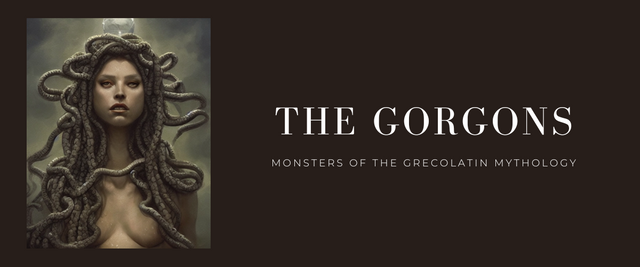Monsters of the Grecolatin Mythology: The Gorgons
Author's note: The following article was published in Spanish language in my Blurt blog, in October 21st, 2022. The image from the banner is elaborated with the artificial inteligence of Starryai app.

Halloween and, in the case of different parts of Latin America, Día de Muertos are just around the corner, although stores have already prepared for the season since the end of September by placing the typical decorations of skulls, bats, ghosts and pumpkins. On television, horror and suspense movie marathons begin, with classic titles such as the Halloween saga, Hocus Pocus, and The Exorcist. Newspapers from time to time take out stories about ghosts and fantastic beings that still persist in the memory of rural communities.
In the Greco-Latin mythological world, these dates don't go unnoticed; unforgettable are the stories about Cyclopes, blood eaters and beings that petrify their victims with a single glance; regarding this last ability, the Gorgons have undoubtedly been the greatest exponents, and they have the honor of being chosen to inaugurate this small mythological cycle dedicated to those monstrous beings whose stories have come down to us through oral and written tradition.
Who were the Gorgons?
Manfred Lurker (1999) mentions that these beings were daughters of the sea god Phorcys and the sea monster Ceto. They lived across the sea, to the west, near the Garden of the Hesperides. Regarding their physical appearance, some versions of the myth compiled by Pierre Grimal (1981) indicate that these beings had hair full of snakes, tusks similar to those of a boar, bronze hands, golden wings and eyes that sparked fire. Both Grimal and Lurker point out that they were three sisters: Esteno, Euríale and Medusa, the latter being the most famous of them due to her confrontation with the hero Perseus, who decapitated her with the help of Athena's shield. An interesting aspect is that Medusa was the only one of the three sisters who wasn't immortal.
Versions on their origins
In Greco-Latin mythology there are different versions of how the Gorgons originated. J. A. Pérez-Rioja (1962) explains that these beings have always had a monstrous appearance that mixed beauty with ugliness, which they used effectively to kill their victims. However, in the versions compiled by Nadia Julien (1997), we are shown that the Gorgons were previously human women of supernatural beauty who were punished by Athena, either for the sacrilege of Poseidon by seducing or raping Medusa in one of her temples, or for daring to compare themselves to the goddess in aesthetic terms.
Curious is the version compiled by Grimal (1981), where he points out that the Gorgons were part of a people of monstrous beings that lived in the confines of Atlantis, famous for their cruelty and their constant conflicts with the Amazons.
The Gorgon as the symbol of protection, life and death
In the myth of Perseus and Medusa, the hero gives Medusa's head to the goddess Athena, which is placed by the deity in her aegis because the head still retained its petrifying powers. In the words of Christine Harrauer and Herbert Hunger (2008), this act shows us the value of the Gorgon's head as a symbol of protection, taking into account the role of the shield as a means of defense. In fact, this symbolism is reinforced by its use in temples and tombs as a defense against demons and evil spirits.
A similar function is observed in the case of the blood that flows from the Gorgon, with the addition that it represents the natural balance of life and death. In the myth of Asclepius, Athena gives Apollo's son two vials of Medusa's blood. The first bottle contained the blood that flowed from the right vein, which had the ability to cure all diseases and restore life; the second bottle contained that which sprouted from the left vein, which had the ability to kill the person (Grimal, 1981: 28). Likewise, her blood possesses a creative and fertilizing capacity, as soon as the winged horse Pegasus and Chrysaor, the man with the golden sword, emerged from her blood, being both the fruit of her previous union with Poseidon, god of the sea and earthquakes.
Consulted bibliography
- Grimal, Pierre. 1981. Diccionario de mitología griega y romana. España. Paidós. [You can find the English version of this book in Amazon with the title: The Penguin Dictionary of Classical Mythology]
- Harrauer, Christine, y Hunger, Herbert. 2008. Diccionario de mitología griega y romana. España. Editorial Herder.
- Julien, Nadia. 1997. Enciclopedia de los mitos. México. Editorial Océano.
- Lurker, Manfred. 1999. Diccionario de dioses y diosas, diablos y demonios. España. Paidós. [You can find the English version of this book in Amazon with the title: The Routledge Dictionary of Gods and Goddesses, Devils and Demons]
- Pérez Rioja, J.A. 1962. Diccionario de mitos y símbolos. Madrid, España. Editorial Tecnos.
Thank you, friend!


I'm @steem.history, who is steem witness.
Thank you for witnessvoting for me.
please click it!
(Go to https://steemit.com/~witnesses and type fbslo at the bottom of the page)
The weight is reduced because of the lack of Voting Power. If you vote for me as a witness, you can get my little vote.
Thank you so much for the support, @steem.history! I really appreciate it! Hugs!